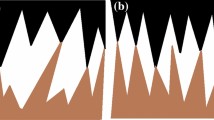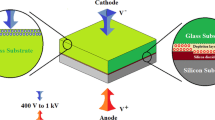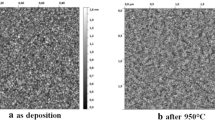Abstract
Standard temperature for anodic bonding process (usually 450 °C) degrade the MEMS device performance due to stress generated on mechanical components during wafer level packaging. The traditional perspective of bonding at medium temperatures (280–350 °C) by various research communities were pertaining to lesser efficiency and un-reliability. Partial bonding and increased number of voids were the results of medium temperature bonding. Here we introduce a new method that reduced the bonding temperature well below to 280 °C for silicon–Pyrex bond and to 320 °C for oxidized silicon–Pyrex bond. This article reports the study of stress reduction (by reducing the bow) in bonding material by decreasing bonding temperature through a modified electrode (cathode) in anodic bonding process. Dropping the temperature from 450 to 280 °C has reduced the bowing effect up to 51 times. Also the effect of glass thickness (2 and 1 mm) on bonding has been studied. It was found that there was a decrease of 49 and 53 % in bow height (at 400 and 450 °C) when used 1 mm thick Pyrex glass instead of 2 mm thick glass. The amount of gas trapped to form voids while bonding by means of the new load, has reduced to a great level. Extensive characterization of the surfaces and interfaces have been made with AFM, OM, SEM and laser bow measurement equipment which defines the surface roughness, cleanliness, bubble formation, interface integrity and surface bow.

















Similar content being viewed by others
References
R. Ramesham, R. Ghaffarian, Challenges in interconnection and packaging of micromechanical systems (MEMS), in 2000 Electronic Components and Technology Conference, May 2000, pp. 666–675
W.P. Eaton, J.H. Smith, Micromachined pressure sensors: review and recent developments. Smart Mater. Struct. 6, 530 (1997)
M.J. Chen, A.V.H. Pham, N.A. Evers, C. Kapusta, J. Iannotti, W. Kornrumpf, J.J. Maciel, N. Karabudak, Design and development of a package using LCP for RF/microwave MEMS switches. IEEE Trans. Microw. Theory Tech. 54(11), 4009–4015 (2006)
G. Rebeiz, RF MEMS: Theory, Design, and Technology (Wiley, Hoboken, NJ, 2003)
R.M. Henderson, L.P.B. Kathehi, Silicon-based micromachined packages for high-frequency applications. IEEE Trans. Microw. Theory Tech. 47(8), 1563–1569 (1999)
S.-A. Kim, Y.-H. Seo, Y.-H. Cho, G. H. Kim, J.-U. Bu, Fabrication and characterization of a low-temperature hermetic MEMS package bonded by a closed loop AuSn solder-line, in IEEE 16th Annual International MEMS Conference, Kyoto, Japan, Jan. 2003, pp. 614–617
F. Niklaus, H. Andersson, P. Enoksson, G. Stemme, Low temperature full wafer adhesive bonding of structured wafers. Sens. Actuators A 92, 235–241 (2001)
R.R. Tummala, E.J. Rymaszewski (eds.), Microelectronics Packaging Handbook (Van Nostrand, New York, 1989)
H. Zhang, H. Xu, Y. Li, Z. Song, H. San, Y. Yu, A Si–glass based pressure sensor with a single piezoresistive element for harsh environment applications. NEMS 2013, Suzhou, China, 7–10 April, 2013
R. Tummala, V. Madisetti, System on chip or system on package? IEEE Des. Test. Comput. 16(2), 48–56 (1999)
G. Wallis, D.I. Pomerantz, Field assisted glass-metal sealing. J. Appl. Phys. 40, 3946–3949 (1969)
A. PlöBl, G. Kräuter, Wafer direct bonding: tailoring adhesion between brittle materials. Mater. Sci. Eng. R25, 1–88 (1999)
M.A. Schmidt, Wafer-to wafer bonding for microstructure formation. Proc. IEEE 86(8), 1574–1585 (1998)
S. Bengtsson, Semiconductor wafer bonding: a review of interfacial properties and applications. J. Electron. Mater. 21(8), 841 (1992)
J. Akhtar, B.B. Dixit, B.D. Pant, V.P. Deshwal, Polysilicon piezoresistive pressure sensors based on based on MEMS technology. IETE J. Res. 49(6), 365–377 (2003)
Q.-Y. Tong, U. Gösele, Semiconductor Wafer Bonding (Wiley, New York, 1999)
M. Harz, W. Brűckner, Stress reduction in anodically bonded silicon and borosilicate glass by thermal treatment, J Electrochem. Soc. 143(4) (1996)
R. Joyce, K. Singh, H. Sharma, S. Varghese, J. Akhtar, Low cost anodic bonding for MEMS packaging applications. Microsyst. Technol. (2013). doi:10.1007/s00542-013-1834-8
K. Singh, R. Joyce, S. Varghese, J. Akhtar, A new method for fast anodic bonding in microsystem technology. Microsyst. Technol. (2013). doi:10.1007/s00542-013-1898-5
M.X. Chen, X.J. Yi, Z.Y. Gan, S. Liu, Reliability of anodically bonded silicon–glass packages. Sens. Actuators A 120, 291–295 (2005)
K. Lin, Some problems of stress release in annealing of commercial flat glass. Glass 27(6), 4–7 (2000). (in Chinese)
Acknowledgments
The Director, CSIR-CEERI, Pilani, Dr. Chandra Shekhar and HOD of SNST, NIT Calicut are thanked for their constant support and encouragement. The authors (RJ) and (KS) heartfully thank Mr. Alex Kurian, Manager R&D, Hero Moto Corp., Dharuhera, Haryana for his continuous support and meaningful discussions. The authors extend their thanks to Mr. G.S. Negi and Mr. Hemant Ajal of CEERI for their continuous support throughout the work.
Author information
Authors and Affiliations
Corresponding author
Rights and permissions
About this article
Cite this article
Joyce, R., Singh, K., Varghese, S. et al. Stress reduction in silicon/oxidized silicon–Pyrex glass anodic bonding for MEMS device packaging: RF switches and pressure sensors. J Mater Sci: Mater Electron 26, 411–423 (2015). https://doi.org/10.1007/s10854-014-2415-z
Received:
Accepted:
Published:
Issue Date:
DOI: https://doi.org/10.1007/s10854-014-2415-z




